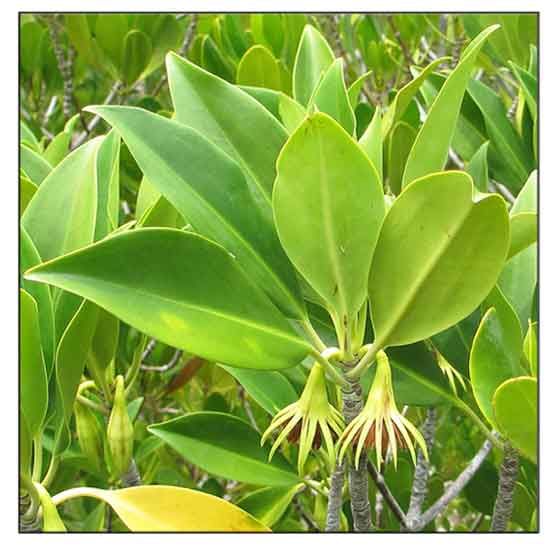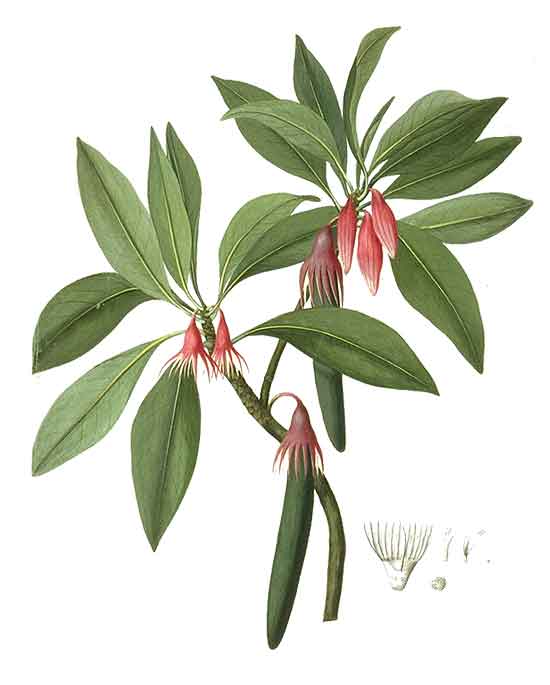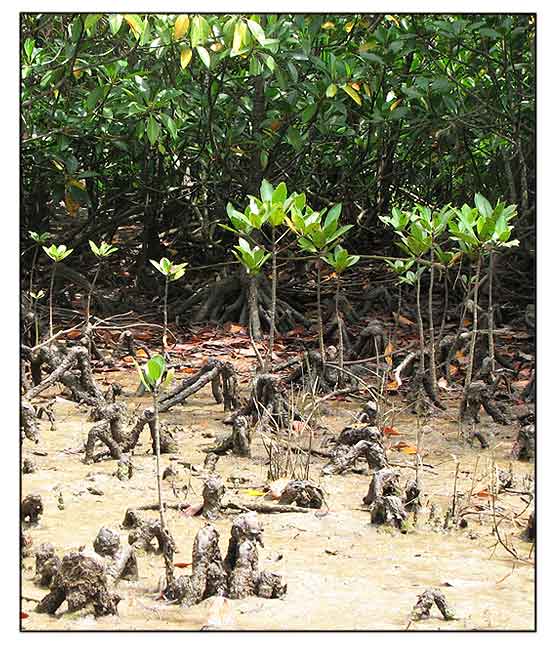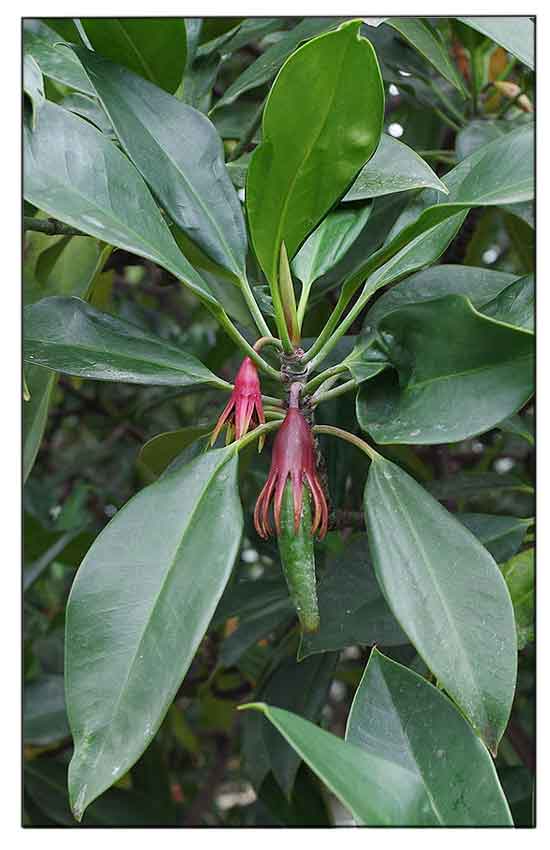 Gen info Gen info
- Bruguiera is a plant genus in the family Rhizophoraceae. It is a small genus of five mangrove species and three hybrids of the Indian and west Pacific Ocean region.
-
Etymology: The genus is named in honor of French explorer and biologist Jean Guillaume Bruguiere (1750-1798)
(19) The specific epithet gymnorrhiza derives from two Greek words gymno, "naked" and rhiza, root, referring to the exposed knee roots emerging from the ground. (see image) (18)
Botany
• A moderate-sized, evergreen tree up to 36 m tall; bole 40-65 cm in diameter, buttressed and with kneed pneumatophores. Bark gray to almost black, roughly fissured, usually with large corky lenticels on buttresses and base of stem. Branching mostly sympodial. Leaves decussately opposite, simple and entire, coriaceous, elliptic to oblong, 8.5-22 cm × 5-7(-9) cm; base cuneate, rarely obtuse, apex acute; nerves 9-10 pairs; petiole 2-4.5 cm long, often reddish; stipules about 4 cm long, often reddish. Flowers solitary, 3-3.5 cm long, generally nodding, with 1-2.5 cm long pedicels, which are bright red on the outside curve; calyx red to pink-red, lobes (10-)12-14(-16), tube usually ribbed at the upper part; petals 13-15 mm long, 2-lobed with acute lobes, each with 3-4 long bristles, outer margins fringed with white silky hairs especially at the base; stamens 8-11 mm long, with linear anthers, embraced by the petals, and twice the number of the petals; ovary inferior, style about 15 mm long with filiform stigma. Fruit a campanulate berry enclosed by the calyx tube, 2-2.5 cm long, 1-celled and 1(-2)-seeded. Hypocotyl cigar-shaped, slightly angular, with a blunt narrowed apex, perforating the apex of the fruit and falling with it, 15-25 cm × 1.5-2 cm.
 • Unlike other members of the Rhizophoraceae, the propagule of B. gymnorrhiza is its fruit. In the Philippines and Indonesia, it develops flowers and fruits yearlong. (19) • Unlike other members of the Rhizophoraceae, the propagule of B. gymnorrhiza is its fruit. In the Philippines and Indonesia, it develops flowers and fruits yearlong. (19)
Distribution
- Native to the Philippines.
- Also native to Aldabra, Andaman Is., Bangladesh, Borneo, Cambodia, Cape Provinces, Caroline Is., China, Christmas I., Comoros, Djibouti, Fiji, Gilbert Is., Hainan, India, Jawa, Kenya, KwaZulu-Natal, Lesser Sunda Is., Madagascar, Malaya, Maluku, Marianas, Marshall Is., Mauritius, Mozambique, Mozambique Channel I, Myanmar, Nansei-shoto, Nauru, New Guinea, New South Wales, Nicobar Is., Northern Territory, Pakistan, Philippines, Queensland, Samoa, Seychelles, Solomon Is., Somalia, Sri Lanka, Sulawesi, Sumatera, Tanzania, Thailand, Tonga, Vanuatu, Vietnam, Wallis-Futuna Is. (1)
- Grows on intertidal mud-flats and estuaries 0-2 m (elevation range between mean sea level and highest tide), on less exposed parts of the coast. Grows on a wide range of soils, but does best in river estuaries. (20)  Constituents Constituents
- In a study of extracts of leaves and barks for total phenolic content, the methanol extract of leaf, methanolic extract of bark and ethanolic extract of bark
showed higher total phenolic contents (mg/GAE/g) at 178.73, 268.47, and 284.93, respectively. (see study below) (3)
- Phytochemical analysis of dried roots yielded flavonoids, reducing sugars, gums, saponins, and tannins, with absence of alkaloid, glycoside, and steroids. (see study below) (5)
- Proximate analysis of leaves and propagules revealed (%) moisture 8.49 and 6.68), ash 8.47 amd 9.17, crude protein 9.62 and 4.37, fat 0.72 and 0.81, crude fiber 15.72 and 10.09, carbohydrates 56.98 and 68.88, and total energy (Kcal/100g) 272.88 amd 300.29, respectively. (see study below) (6)
- Phytochemical analysis of the mangrove leaf extract yielded alkaloids, flavonoids, tannins, and phenolic groups. (see study below) (11)
- Thin layer chromatography profiling revealed presence of phenolic, terpene, and alkaloid compounds in crude methanol, diethyl ether, and butanol extracts. (see study below) (13)
- Study of petroleum ether extract of flowers isolated three new dammarane triterpenes, bruguierins A-C (1-3). (see study below) (14)
- Study of proximate composition of fruit yielded high carbohydrate content 29.28%, moisture 66.39%, protein 2.11%, fat 1.07%, and ash 1.15%. (see study below) (17)
Properties
- Studies have suggested antibacterial, antioxidant, antifungal, colitis-protective, antidiarrheal, antidiabetic, antihyperlipidemic, anti-inflammatory, antinociceptive properties
Parts used
Leaves, bark, fruit, roots.
 Uses Uses
Edibility
- In the Moluccas, leaves and peeled hypocotyls are eaten in times of scarcity, after soaking in water and boiling.
- For the Sowek people of Supiori Island, Papua Province, Indonesia, the fruit is a food staple, due to high carbohydrate content. (20)
-
In Jakarta, starchy
central part of the hypocotyl treated with sugar for food.
Folkloric
- Bark used as astringent medicine against diarrhea and, sometimes, malaria.
- Fruit used for treatment of diarrhea.
- Fruit, bark and leaves used for treatment of diarrhea and fever, diabetes, burns, intestinal worms, and liver disorders. Stems used for viral fever. Bark, roots, and leaves used for treatment of diarrhea, malaria, and burns. In the Solomon Islands, bark used for treatment of malaria and burns, and as abortifacient. In Cambodia, bark used as astringent to treat malaria. (6)
Others
- Tanning: Bark used for tanning leather and fishing nets; contains 35% tanning substance in air-dry bark.
- Dye: A phlobaphene coloring matter from the bark is sometimes used in Malaysia and Vietnam for a black or dark-brown color.
- Wood: Used for piles, house posts, rafters, fishing stakes, paddles, and telegraph poles.
- Fuel: Wood has high calorific value, and used as fuel and for charcoal production.
- Agroforestry: Contributes to coastal stability and protection by trapping sediment and keeping sea storms and winds at bay, minimizing erosion and damage. (6)
Studies
• Antimicrobial / Antioxidant / Phenolic Contents / Leaves and Bark: Study evaluated the antioxidant and antibacterial activities of methanolic, ethanolic, and chloroform crude extracts of leaves and barks of B. gymnorrhiza. The ethanol extract showed best result in all antioxidant assays (superoxide dismutase determination, reducing power assay, and DPPH radical scavenging assays), with no significant difference in IC50s of ethanol bark extract and ascorbic acid. Ethanol and methanol extracts inhibited the growth of all pathogenic bacteria tested viz., E. coli, P. aeruginosa, S. aureus, B. cereus, while chloroform extract of leaves showed no activity. The ethanol extract of bark showed higher antimicrobial effect. (see constituents above) (3)
• Protective Effect in Induced Ulcerative Colitis / Role of Gut Microbiota / Fruit: Study evaluated the effect and mechanism of B. gymnorrhiza fruit on experimental colitis induced by oral intake of dextran sulfate sodium (DSS) and treated with aqueous extract of BGF (25, 50, 100 mg/kg) for a week. Results showed BGF was rich in pinnitol, and showed strong antioxidative activity in vitro. BGF effectively reduced body weight loss and disease activity index (DAI), restored colon length, repaired colonic pathological variations, and decreased histological scores, which was superior to salicylazo-sulfapyridine (SASP). BGF decreased levels of MDA and inflammatory mediators (TNF-α, IL-6, IL-1ß, and IFN-γ, increased level of IL-10, and prevented depletion of SOD and GSH. BGF promoted the growth of probiotics in the gut, and inhibited the colonization of pathogenic bacteria. Results suggest BGF possess protective effect against DSS-induced colitis. The mechanism may involve the amelioration of inflammatory and oxidative status, activation of Keap1/Nrf2 signaling pathway, and the maintenance of micro-ecological balance of the host. (4)
• Antinociceptive / Antidiarrheal / Roots: Study evaluated roots extracts for antinociceptive and antidiarrheal activities in Swiss albino mice. Methanol root extracts inhibited castor-oil induced diarrhea. Flavonoids can inhibit release of autacoids and prostaglandins, and can inhibit motility and secretion induced by castor oil. Also, the antidiarrheal activity may be due to denatured proteins forming protein tannates, which make the intestinal mucosa more resistant and reduced secretion. The extract produced significant inhibition of writhing in acetic acid-induced writhing in mice at oral dose of 250 and 500 mg/kbw (p<0.001) comparable to standard drug diclofenac. (see constituents above) (5)
• Antifungal / Antibacterial / Antioxidant / Leaf, Root, Bark: Study evaluated successive methanol and combination solvent extracts against ten pathogenic bacteria and four fungal strains. Dried root extract showed maximum effectiveness on tested organisms with ZOI of 22.31mm followed by bark extract ZOI 21.63 mm against Penicillium chrysogenum. Different combinations of solvent extracts exhibited optimal MICs against Micrococcus sp. (7.26 µg/ml) and Streptococcus mitis )(7.62 µg/ml). Methanolic root extracts showed maximal quantity of phenolics of 25.36 µg GAE and 69.64% DPPH activity. A combination root extract showed maximum 96.07% ferric reducing antioxidant power. Results showed crude extracts have noteworthy toxicity against bacterial pathogens and Candida albicans. Combination solvent extracts showed more promising results. (7)
• Antioxidant / Anti-Hemolytic / Cytotoxic / Antibacterial: Study of crude methanolic extracts of B. gymnorrhiza yielded 58.917 mg GAE/g and 76.417 mg QE/g. The methanol extracts also exhibited high radical scavenging activity against DPPH, H2O2, and Fe2+ radicals. Reductive capacity increased with increasing concentration. The extract also inhibited H2O2 induced hemolysis in human RBCs. Antioxidant property was weaker than reference standard, L-ascorbic acid and gallic acid. The extract exhibited significant cytotoxicity by brine shrimp lethality assay (241.4 µg/ml). The ME also inhibited the growth of pathogenic bacterial stains. (8)
• Antidiabetic / Antihyperlipidemic / Bark: Study evaluated the antidiabetic activity of ethanolic extract of B. gymnorrhiza bark against STZ-induced diabetic rats. Dose of 400 mg/kbw for 21 days reduced blood sugar, along with significant reduction in total cholesterol, LDL, VLDL, and improvement in HDL cholesterol. (9)
• Effect on SCFA, Satiety Hormone, Systemic Inflammation, Lipid Profile / Fruit Flour: Bruguiera gymnorrhiza has potential as a function food because of its dietary fiber content and bioactive components like flavonoids and phenolic compounds. Study evaluated the effects of BG fruit flour (BGF) on satiety hormone, lipid profile, systemic inflammation, body weight, and caecum SCFA (short-chain fatty acid) levels on diet-induced obese male Wistar rats. The BGF intervention increased dose-dependent plasma GLP-1 and PYY levels, decreased lipid profiles and systemic inflammation in a dose-dependent manner, and higher acetate, propionate, and total SCFA concentrations. Results showed BGF intervention improved satiety hormone, lipid profile, systemic inflammation and SCFA levels. (10)
• Effect on Fish Pathogenic Bacteria / Leaves: Study evaluated the bioactivity of B. gymnorrhiza leaf extract against fish pathogenic bacteria. The extract strongly inhibited Pseudomonas aeruginosa and Aeromonas hydrophila. Staphylococcus aureus was only weakly inhibited. (see constituents above) (11)
• Zinc Oxide Nanoparticles / Antimicrobial / Antioxidant / Leaves: Study reports on the green synthesis of ZnO nanoparticles using aqueous leaf extract of B. gymnorrhiza as reducing agent. The ZnONPs showed excellent bactericidal activity on B. subtilis, S. aureus, S. typhi, and E. coli. By DPPH assay the NPs showed potent antioxidant activity. (12)
• Cytotoxicity / Human Breast Carcinoma (MCF-7) Cell Line: Study evaluated the growth inhibitory effect and mechanism of B. gymnorrhiza extract on MCF-7 by MTS assay. Butanol extract exhibited maximum cytotoxicity against MCF-7 cells with IC50 of 3.39 µg/mL via induction of apoptosis (DNA fragmentation) via activation of intrinsic pathway. Butanol and diethyl ether extracts significantly increased the caspase-3 level. Results suggest potential as future therapeutic agent against breast cancer. (see constituents above) (13)
• Anti-Inflammatory / Dammarane Triterpenes / Flowers: Study of petroleum ether extract of flowers isolated three new dammarane triterpenes, bruguierins A-C (1-3).
With stably transfected HepG2 cells, the isolates activated antioxidant response element (ARE luciferase activation) with EC50 values of 7.8, 9.4, and 15.7 µM, respectively. Bruguierin A (1) also inhibited phorbol ester-induced NFkB luciferase activation with IC50 of 1.4 µM and selectively inhibited COX-2 activity with IC50 of 0.37 µM. (14)
• Bruguierols / Antibacterial / Stems: Phytochemical study of stem yielded five new aromatic compounds (1-5), including bruguierols A-C (1-3). Compound 3 showed moderate activity against Gram-positive and Gram-negative bacteria including mycobacteria and resistant strains (MICs 12.5 µg/ml). (15)
• Anti-Inflammatory / Leaves: Study evaluated the anti-inflammatory activity of methanol fraction of B. gymnorrhiza leaves using in vitro and in vivo models. Leaf extract produced significant inhibition of both carrageenan induced rat paw edema and acetic acid induced peritoneal capillary permeability. In invitro models, the extract significantly inhibited both cyclooxygenase (COX) and lipoxygenase (LOX) enzymes. The extract also inhibited production of proinflammatory cytokines (TNF-α, IL-6, and IL-1ß) in lipopolysaccharide (LPS)-stimulated peripheral blood mononuclear cells (PBMCs) in a dose dependent manner. Extract also exhibited significant free radical (DPPH, superoxide and oxide radical) scavenging activity. Results suggest significant anti-inflammatory activity, probably mediated via blockade of both COX-LOX pathway, coupled with scavenging effect of free radicals. (16)
Availability
Wild-crafted.
|

![]()




 • Unlike other members of the Rhizophoraceae, the propagule of B. gymnorrhiza is its fruit. In the Philippines and Indonesia, it develops flowers and fruits yearlong. (
• Unlike other members of the Rhizophoraceae, the propagule of B. gymnorrhiza is its fruit. In the Philippines and Indonesia, it develops flowers and fruits yearlong. (
 Uses
Uses